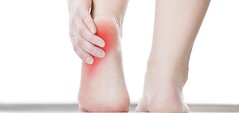with Network Meta-Analysis
Menz HB, van der Windt D, Roddy E. Br J
Sports Med. 2018. [Epub ahead of print]
increase function; however, a corticosteroid injection with or without exercise
may be most beneficial.
Plantar heel pain is common in the
general and athletic population. It is likely caused by multiple factors, which
can make its treatment lengthy and frustrating. There are many conservative
treatment options (watchful waiting, injections, orthoses); however, we don’t
know how to rank the effectiveness of these treatments. One solution to this
problem is a network meta-analysis, which allows researchers to assess multiple
treatments at once and rank the treatments. Therefore, the authors conducted a network
meta-analysis of 31 clinical trials to evaluate the effectiveness of the
treatments for relieving pain and increasing function in patients with plantar
heel pain. The randomized clinical trials included in this review met the several
criteria: participants were 18 years or older (2450 participants), had specific
information on dosage and procedures, and had outcome measures collected at
least 24 hours after treatment (ranged from 4 to 104 weeks). The studies
included 10 different or combinations of exercise therapy, corticosteroid
injections, non-steroidal anti-inflammatory drugs (NSAIDs), orthoses, extracorporeal
shockwave therapy (ESWT), or usual care/placebo. The authors collapsed primary
outcomes of pain and function into 3 categories: short term (1 to 6 weeks),
medium term (6 to 12 weeks), or long term (> 12 weeks). The authors found no
clear evidence that any treatment was best. However, ESWT or a corticosteroid
injection with or without exercise therapy may offer the best results over all
time frames. Exercise, which might not be helpful in the short- or medium-term
may offer long-term benefits.
though the authors failed to find one treatment option was best for improving
pain or function, they were able to rank the commonly used treatments for heel
pain. The ranking system revealed that corticosteroid injections with or
without exercise therapy reduced pain and improved functional outcomes across
all time frames. However, we should be cautious because of the wide variability
in the possible benefits of these treatments. Placebo (watchful waiting) was
not surprisingly the least effective; however, of note was that NSAIDs and
orthoses ranked lower than one might expect. Given the limited information on
the long-term effects of these treatment options and the doubts about what may
be the ideal treatment option more robust randomized trials are needed to
identify the best treatment for heel pain. At this time, exercise had the best
outcomes over a long term. Medical professionals should be mindful of these
findings when they suggest options such as watchful waiting, expensive
orthosis, or NSAIDS that could have negative side effects that may not be helpful
in treating patients with heel pain. It may also be worthwhile to discuss the
benefits of an injection with a home exercise plan to relieve pain and offer
long-term benefits.
pain? What exercises or treatments do you perform to help increase function in
patients with heel pain?


